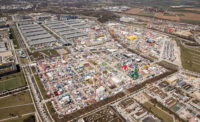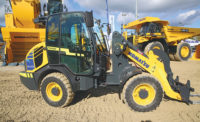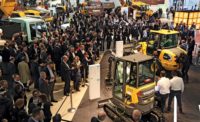MUNICH—High-tech advances in concrete placement and futuristic designs for heavy equipment were some of the winners of the 2016 Bauma Innovation Awards, held April 10 in Munich, Germany.
The invitation-only awards ceremony was held on the eve of the triennial Bauma construction equipment trade show. Organizers polled a panel of industry and academic judges as well as international journalists to select the best innovations in construction equipment technology across five categories.
The winners of the Bauma Innovation Awards were winnowed down from 118 entries. Judges' choices this year focused on products that promote sustainability and efficiency.
(Watch: The nominees for the Bauma Innovation Award, Machinery)
The Kramer 5055e electric wheel loader from Wacker Neuson took home the award in the construction machinery category. Intended for indoor and underground work, the wheel loader is the first all-electric model in its size class. With a 0.55-cubic-meter bucket with a 2.7-metric-ton lift capacity, the wheel loader can be used for for heavy earthmoving in tunneling and other spaces with poor ventilation. The forklift-style lead-acid batteries can hold enough charge for 5 hours of continuous work, and the wheel loader can also be used to power-corded hand tools.
(Watch: The nominees for the Bauma Innovation Award, Components)
The SONO-WZ Water/Cement Analyzer from IMKO won the component category. Radar signals are emitted into fresh concrete to calculate the water-cement ratio without extensive further testing, saving a lot of time during quality control. The tool is able to calculate not only the moisture percentage of the concrete, but can also show the water content by volume if the user inputs the known mass density of the mix.
(Watch: The nominees for the Bauma Innovation Award, Process)
German construction firm Leonhard Weiss took the prize in this category with its method for extending the life of aging, orthotropic steel-deck bridges by replacing much of the roadway with a layer of high-strength, reinforced concrete. A successful demonstration project by Leonhard Weiss significantly improved the performance of an existing steel-deck bridge at a fraction of what a new span would cost.
(Watch: The nominees for the Bauma Innovation Award, Research)
There was a clear winner in this category. The concrete 3D-printing technology from the Dresden University of Technology investigated how the principles of additive manufacturing could be scaled up to concrete placement. A “print nozzle” would be mounted to a concrete boom and build concrete structures onsite without the need for formwork. The technology has yet to be proven at full-scale on a job site, but lab results have been promising.
(Watch: The nominees for the Bauma Innovation Award, Design)
This one was too close to call, and judges elected to award the prize equally to the top two entries.
The French-based division of equipment maker Mecalac was honored for its redesigned small wheeled excavator. By designing a narrower upper structure that can swing over the wheels, the machine’s turntable could be dropped down, lowering the center of gravity and improving stability. "It has a consistent and balanced design, that stands for momentum and high quality," noted Dag Holmgren, a Swedish-based industrial designer and one of the judges. "It takes the excavator into an compact design, with the boom folding into the frame."
Meanwhile, a joint team from the Dresden University of Technology and several European equipment manufacturers has been working on the Genius Cab, a concept design for the operator cab in future construction equipment. The design seeks to maximize operator visibility while still maintaining a high level of ROPS coverage. Integrated sensor packages will keep the operator informed about their environment, while also serving as a security system to prevent unauthorized use.
This was the 11th time the Innovation Awards have been held at Bauma. The show opens April 11 and will continue until April 17. Nearly 3,400 exhibitors with display their wares to more than 500,000 expected attendees.






Post a comment to this article
Report Abusive Comment